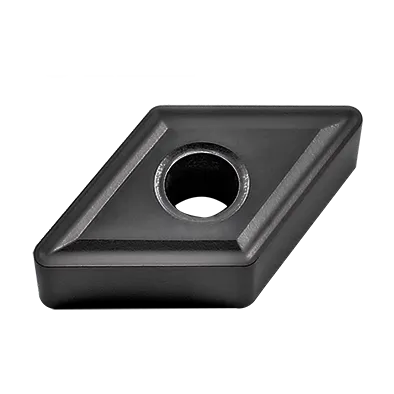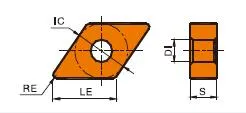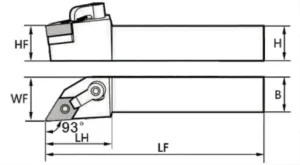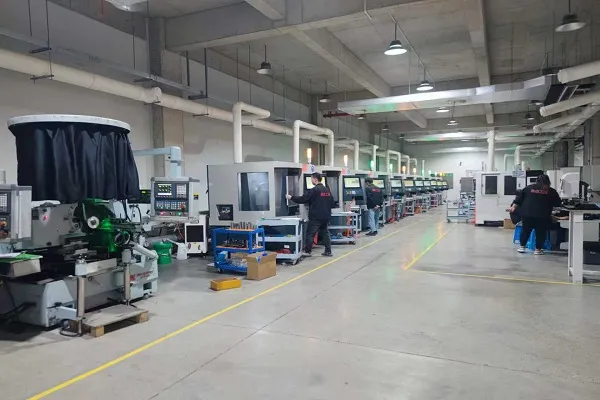

DNMG-Einsatz
DNMG insert angle: 0° Negative Rake Insert with double-sided Chipbreaker;
55 ° Rhombischer Dreheinsatz;
Recommended for steel, stainless steel, and cast iron and etc;
Breaker Application: Rough, Semi-finishing, Finishing machining;
Matching DNMG insert holder: PDJNR/L, PDNN, MDJNR, MDPNN;
Application industry: DNMG Insert is widely applied in automobile, aerospace, 3C and other industries;
Range of DNMG insert types:DNMG150404/DNMG150408/DNMG331/DNMG332/DNMG431/DNMG432/DNMG/433;
Grade: Both PVD and CVD;
Material: Wolframcarbid;
DNMG insert specification
Our premium DNMG inserts are crafted from high-quality cemented carbide for exceptional performance.
Advanced quenching techniques and specialized surface coatings make them incredibly durable, resisting wear, heat, impact, and corrosion.
Plus, we’ll customize them to perfectly match your equipment and working conditions.
Expect unmatched accuracy, long service life, and outstanding cost-effectiveness.
That’s why these inserts are trusted worldwide in demanding industries like automotive, aerospace, and 3C manufacturing.
DNMG insert Meaning
Understanding the DNMG Insert Code
- D: Form: Rhombisch (Diamant) mit einem 55-Grad-enthaltenen Winkel.
- N: Clearance Angle: 0 degrees.
- M: Tolerance: Medium tolerance is standard, though other precision tolerances may exist.
- G: Spanbrecher-Stil & Lochkonfiguration. In diesem Buchstaben werden die spezifische Chipbreaker -Geometrie bezeichnet und ob der Einsatz ein Loch hat oder nicht. Chipbreaker-Variationen sind zahlreich und Herstellerspezifisch.
- Numerische Ziffern:
- Die ersten beiden Ziffern: Eingeschriebener Kreisdurchmesser (IC) in Millimetern. Um das ungefähre Zentimeteräquivalent zu erhalten, teilen Sie diese Zahl durch 25,4 auf.
- Nächste zwei Ziffern: Dicke in Millimetern. Teilen Sie sich um 25,4, um in Zoll umzuwandeln.
- Die letzten zwei Ziffern: Nasenradius in Millimetern. Um in Zoll umzuwandeln, teilen Sie sich um 25,4.
DNMG insert holder


MDJNRL

MDPNN

DNMG Insert Dimensions (ISO and INCH)
| DNMG Designation(ISO) | DNMG Designation(INCH) | Eingeschriebener Kreis (IC) | Dicke | Gemeinsame Eckradien |
|---|---|---|---|---|
| DNMG 110404 | DNMG331 | 11mm (0.433") | 4.76mm (0.187") | 0.4mm (0.016") |
| DNMG 110408 | DNMG332 | 11mm (0.433") | 4.76mm (0.187") | 0.8mm (0.031") |
| DNMG 150404 | DNMG431 | 15.875mm (0.625") | 4.76mm (0.187") | 0.4mm (0.016") |
| DNMG 150408 | DNMG432 | 15.875mm (0.625") | 4.76mm (0.187") | 0.8mm (0.031") |
| DNMG 150608 | DNMG442 | 15.875mm (0.625") | 6.35mm (0.25") | 0.8mm (0.031") |
| DNMG 190612 | DNMG543 | 19.05mm (0.75") | 6.35mm (0.25") | 1.2mm (0.047") |
Example: DNMG 150608
- Rhombische (Diamant-) Form mit einem 55-Grad-enthaltenen Winkel
- 0-Grad Freiwinkel
- Mittlere Toleranz
- Herstellerspezifische Chipbreaker- und Lochkonfiguration
- 15.875mm inscribed circle diameter (approx. 0.625″ in Zoll)
- 6.35mm thick (approx. 0.25″ in Zoll)
- 00,8 mm Nasenradius (ca. 0,031″ in Zoll)
The Science Behind Carbide Inserts: How They're Made and Why They're So Strong
Hartmetalleinsätze gehören zu den vielseitigsten und langlebigsten Schneidwerkzeugen auf dem Markt. Aber wie werden sie hergestellt? Und was macht sie so stark? In diesem Video erkunden wir die Wissenschaft hinter Hartmetalleinsätzen, von den Eigenschaften von Wolframkarbid bis zum Herstellungsprozess.
Unsere Produktionskapazität










